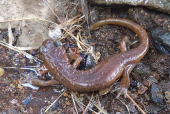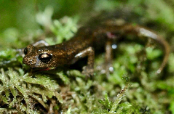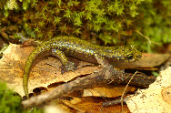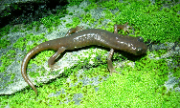Limestone Salamander (Hydromantes brunus)
Description: The limestone salamander has a flattened body, head, webbed toes, and a short tail. It is typically 5.0 to 7.5 cm in length. Adults are brownish with a pale ventral surface; the male has oval shaped mental gland. The species was originally thought to be life-birthing,[2] but is now known to lay eggs. Young hatch in the egg and emerge fully formed, with no larval stage. They are yellowish greenish, darkening with age. Like all lungless salamanders, it respires through its skin.
Habitat: Habitats include moss covered limestones outcroppings, chaparral, under rocks and logs in moist environments. During dry weather it stays underground in caves and rock crevices.
Range: The genus Hydromantes is endemic to California. The limestone salamander occurs only in the Lower Merced River drainage, in several disparate localities, at elevations of 300 to 760 meters in inhabits canyon slopes that are greater than 35 degrees.
Found in these States:
CA
Diet: Probably consumes a variety of small invertebrates.
Reproduction: Little is known about the breeding behavior of this species. Reproduction is terrestrial. Females lay eggs most likely in deep moist talus or crevices in late spring. Young develop completely in the egg and hatch fully formed in the summer. Summer is hot and dry in the range of the Limestone Salamander, so hatchlings probably remain underground until at least the following fall rains.
Status: Listed as Near Threatened because the continued survival of this species is entirely dependent on the protection and rigorous management of its habitat provided by the Bureau of Land Management through the Limestone Salamander Ecological Reserve (LSER) and the Limestone Salamander Area of Critical Environmental Concern (ACEC). Without this level of protection, it is very likely that the speciesí habitat would be degraded and fragmented resulting in significant population declines, which would warrant an immediate uplisting.
»» Kingdom: Animalia - Animals
»» Phylum: Chordata - Chordates
»» Subphylum: Vertebrata - Vertebrates
»» Class: Amphibia - (Amphibians)
»» Order: Caudata - Salamanders
»» Family: Plethodontidae - Lungless Salamanders
»» Genus: Hydromantes
»» Species: Hydromantes brunus - Limestone Salamander
This article uses material from the Wikipedia article "Limestone Salamander", which is released under the Creative Commons Attribution-Share-Alike License 3.0. Content may have been omitted from the original, but no content has been changed or extended.
|












